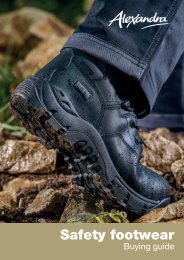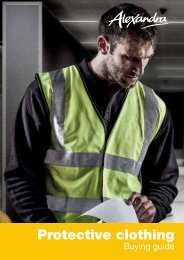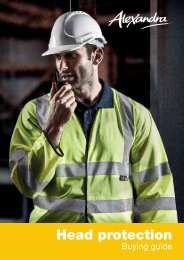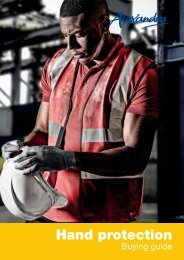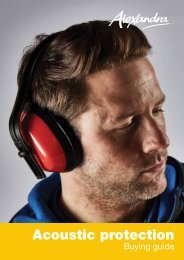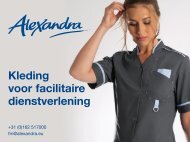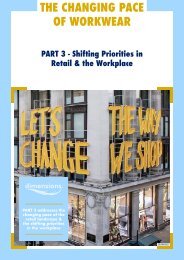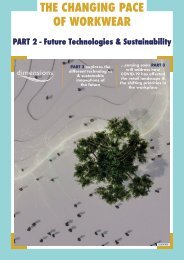Alexandra - Respiratory Buying Guide
You also want an ePaper? Increase the reach of your titles
YUMPU automatically turns print PDFs into web optimized ePapers that Google loves.
<strong>Respiratory</strong><br />
<strong>Buying</strong> guide
<strong>Respiratory</strong><br />
<strong>Buying</strong> guide<br />
<strong>Respiratory</strong> protective equipment at work<br />
There are many types of respiratory protective equipment (RPE) available, designed<br />
to protect people from a variety of hazards in the workplace. These suit a variety of<br />
workplace situations and should match the specific requirements of the wearer. Many<br />
workers wear respirators or breathing apparatus to protect their health; these devices<br />
are collectively known as respiratory protective equipment (RPE). Respirators filter the<br />
air to remove harmful substances and breathing apparatus (BA) provides clean air for the<br />
worker to breathe.<br />
Choosing the<br />
right protection<br />
for your task<br />
Work activities may result in harmful<br />
substances contaminating the air in the form<br />
of dust, mist, gas or fume. Workers may<br />
also need to work in areas where oxygen<br />
levels are low such as confined spaces, a<br />
chamber or tank. RPE is designed to protect<br />
the wearer from these hazards:<br />
Whether you are an employer or self-employed, this guide will help those who have<br />
responsibility for the use of RPE at work.<br />
RPE should be used when there is a possibility of breathing in contaminated air, even if<br />
other controls are in place, such as an extraction system. The respirators use filters to<br />
remove contaminants from the air, allowing the wearer to breathe safely.<br />
Work activities may result in harmful substances contaminating<br />
the air in the form of dust, mist, vapour, gas or fume.<br />
For example, when:<br />
• Cutting a material such as stone or wood.<br />
• Using a product containing volatile solvents.<br />
• Handling a dusty powder.<br />
• Welding stainless steel.<br />
To select RPE that will protect the wearer you will need a basic<br />
understanding of:<br />
• The hazardous substance and the amount in the air (exposure).<br />
• The form of the substance in the air (e.g. gas, particle, vapour).<br />
• The type of work being carried out.<br />
• Any specific wearer requirements, such as other PPE being worn at the same time,<br />
or a need for spectacles.<br />
Respirators are rigorously tested to make sure they meet varying levels of industry safety<br />
standards, for example:<br />
EN149 • EN143 • EN405 • EN114387.<br />
Efficiency<br />
Construction<br />
Metal<br />
fumes<br />
Fibres<br />
Woods<br />
Painting<br />
Filtration efficiency (80 - 99%)<br />
Anti-clogging (D)<br />
Silica<br />
Brick dust<br />
Concrete<br />
Plaster<br />
Sandstone<br />
Welding<br />
Ferrous metal fume<br />
Lead fume<br />
Fibre glass strand<br />
Mineral fibres<br />
Rockwool insulation<br />
Wood (soft)<br />
Wood (hard)<br />
MDF hand tools<br />
Water based<br />
Powered prep<br />
Manual prep<br />
Mechanical stripping
Specific requirements for RPE use<br />
A fit test should be performed before entering a contaminated or hazardous area to ensure that the RPE is working correctly for you.<br />
RPE is available in different sizes to allow for the facial differences of workers. Gender, ethnicity, build and many other factors mean that one size of<br />
face piece will not fit everyone.<br />
You will require RPE that is adequate and suitable to ensure the wearer is protected. This means:<br />
• Adequate – It is right for the hazard and reduces exposure to the level required to protect the wearer’s health.<br />
• Suitable – It is right for the wearer, task and environment, such that the wearer can work freely and without additional risks due to the RPE.<br />
Other common factors about the wearer you need to consider are:<br />
• Do they have facial hair or markings that could prevent a good seal between the wearer’s face and the RPE?<br />
• Do they have any pre-existing medical conditions?<br />
• Do they wear spectacles or contact lenses?<br />
Remember, (RPE) can protect only the wearer if it is used correctly. If poorly maintained or used incorrectly, it will not provide the required<br />
protection. (RPE) can be uncomfortable to wear and may interfere with work, which can lead to incorrect use.<br />
For more information and further guidance, please visit: www.hse.gov.uk<br />
Choosing the suitable protection for your task<br />
Below is a graph with information to help you select the type of RPE that best suits you and the task at hand. It depicts the level of filtration<br />
efficiency, the types of protection offered and which EN standard it relates to:<br />
EFFICIENCY<br />
CONSTRUCTION<br />
METAL<br />
FUMES<br />
FIBRES WOODS PAINTING<br />
CODE VALVE EN STANDARD<br />
% FILTRATION<br />
ANTI-CLOGGING (D)<br />
SILICA<br />
BRICK DUST<br />
CONCRETE<br />
PLASTER<br />
SANDSTONE<br />
FERROUS<br />
LEAD<br />
GLASS STRANDS<br />
MINERAL<br />
ROCKWOOL INSULATION<br />
SOFT<br />
HARD<br />
MDF HAND TOOLS<br />
WATER BASED<br />
POWERED PREP<br />
MANUAL PREP<br />
MECHANICAL STRIPPING<br />
PE11 FFP2V EN149 94 • • • • • • • • • •<br />
PE12 FFP2V EN149 80 • •<br />
PE13 FFP3V EN149 99 • • • • • • • • • • • • • • • • • •<br />
<strong>Alexandra</strong> West Park House Midland Way Thornbury Bristol BS35 2NT<br />
t 0333 600 1111 f 0333 700 2222<br />
alexandra.co.uk








